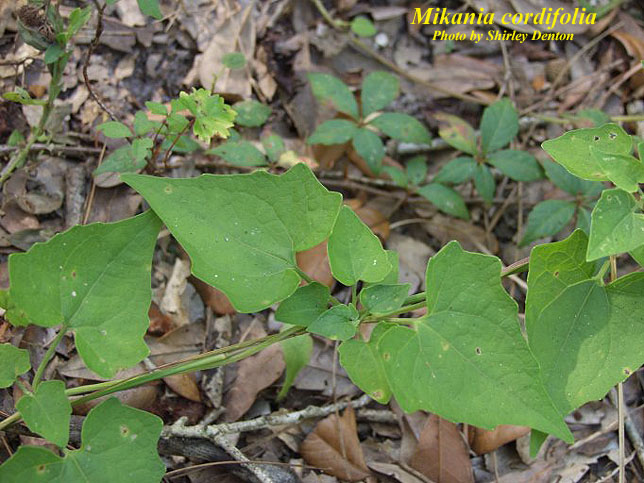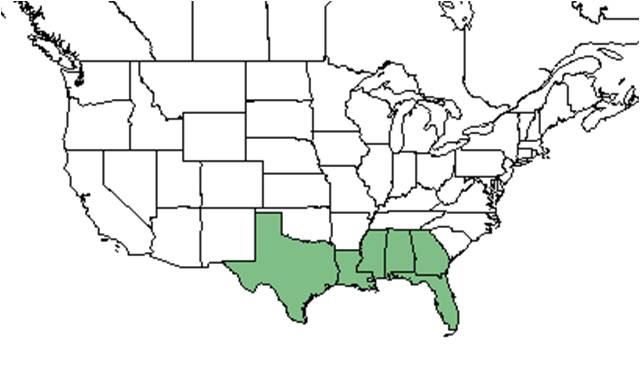Difference between revisions of "Mikania cordifolia"
Krobertson (talk | contribs) (→Distribution) |
Krobertson (talk | contribs) (→Cultivation and restoration) |
||
| Line 61: | Line 61: | ||
==Conservation and management== | ==Conservation and management== | ||
==Cultivation and restoration== | ==Cultivation and restoration== | ||
| − | In Brazil, it is popularly known as "guaco" and is used to treat respiratory problems and snake bites. It is known to contain diterpenes, sesquiterpenes and phenylproanoids which have therapeutic affects. <ref name="de Oliveira et al. 2007">de Oliveira, P. A., L. E. Gregorio, et al. (2007). "Comparative analysis of sesquiterpene lactones from Mikania cordifolia collected from three different location." Chemistry of Natural Compounds 43(2).</ref> In Surinam, it is used to treat measles and French Guinana is used to treat skin rashes and scabies <ref name="eol">[[http://eol.org/pages/468841/details]]Encyclopedia of Life Accessed: February 10, 2016</ref> | + | In Brazil, it is popularly known as "guaco" and is used to treat respiratory problems and snake bites. It is known to contain diterpenes, sesquiterpenes and phenylproanoids which have therapeutic affects. <ref name="de Oliveira et al. 2007">de Oliveira, P. A., L. E. Gregorio, et al. (2007). "Comparative analysis of sesquiterpene lactones from Mikania cordifolia collected from three different location." Chemistry of Natural Compounds 43(2).</ref> In Surinam, it is used to treat measles and French Guinana is used to treat skin rashes and scabies.<ref name="eol">[[http://eol.org/pages/468841/details]]Encyclopedia of Life Accessed: February 10, 2016</ref> |
| + | |||
==Photo Gallery== | ==Photo Gallery== | ||
<gallery widths=180px> | <gallery widths=180px> | ||
Revision as of 12:44, 18 August 2016
| Mikania cordifolia | |
|---|---|

| |
| Photo by Shirley Denton (copyrighted, use by photographer's permission only), Atlas of Florida Vascular Plants | |
| Scientific classification | |
| Kingdom: | Plantae |
| Division: | Magnoliophyta - Flowering plants |
| Class: | Magnoliopsida – Dicotyledons |
| Order: | Asterales |
| Family: | Asteraceae ⁄ Compositae |
| Genus: | Mikania |
| Species: | M. cordifolia |
| Binomial name | |
| Mikania cordifolia (L. f.) Willd. | |

| |
| Natural range of Mikania cordifolia from USDA NRCS Plants Database. | |
Common name: Florida Keys hempvine
Contents
Taxonomic notes
Synonyms: Cacalia cordifolia Linnaeus f.; Willoughbya halei Small USDA NRCS Plants Database
Description
A description of Mikania cordifolia is provided in The Flora of North America.
It can be distinguished from other Mikania by having hexagonally ridged stems. [1] It is not as woody as other lianas and little cork is formed due to a continuous cambium. After being wounded, the ray cells produce a substantial callus that grows onto the peripheral surface of the xylem. [2]
Distribution
M. cordifolia is native to the southeastern United States, Mexico, the West Indies, Central and South America.[3]
Ecology
Habitat
In the Coastal Plain in Florida, M. cordifolia can occur in mixed hardwood forests, wooded slopes along rivers, creek bottoms, climbing on shrubs in limestone ledges, live oak hammocks, cabbage palm hammocks, creek banks, and calcareous wooded bluffs. Associated species include Cabbage palm, Pinus palutris, Quercus virginiana, Acer, Liquidambar styraciflua, Thelypteris, Ageratina, and Arnoglossum diversifolium. It has been observed to grow in rich humus soils. [4]
Phenology
Flowers September through December. [4]
Pollination
The following Hymenoptera families and species were observed visiting flowers of Mikania cordifolia at Archbold Biological Station: [5]
Apidae: Bombus impatiens
Colletidae: Colletes mandibularis, Hylaeus graenicheri, H. schwarzi
Halictidae: Augochlorella aurata, Augochloropsis anonyma, A. metallica, A. sumptuosa, Lasioglossum miniatulus, L. nymphalis
Leucospididae: Leucospis affinis, L. robertsoni, L. slossonae
Megachilidae: Coelioxys mexicana, C. sayi, Megachile albitarsis, M. brevis pseudobrevis, M. mendica, M. xylocopoides
Sphecidae: Bicyrtes quadrifasciata, Crabro hilaris rufibasis, Ectemnius rufipes ais, Isodontia exornata, Oxybelus laetus fulvipes
Vespidae: Eumenes fraternus, E. smithii, Leptochilus republicanus, Pachodynerus erynnis, Polistes bellicosus, P. dorsalis hunteri, Polistes perplexus, Stenodynerus fundatiformis, S. histrionalis rufustus, S. lineatifrons, S. pulvinatus surrufus
Vespidae: Zethus slossonae, Z. spinipes
Conservation and management
Cultivation and restoration
In Brazil, it is popularly known as "guaco" and is used to treat respiratory problems and snake bites. It is known to contain diterpenes, sesquiterpenes and phenylproanoids which have therapeutic affects. [6] In Surinam, it is used to treat measles and French Guinana is used to treat skin rashes and scabies.[7]
Photo Gallery
References and notes
Nauman, C. E. (1981). "A Re-Examination of Mikania Willd. (Compositae) in Florida." Bulletin of the Torrey Botanical Club 108(4): 467-471.
- ↑ Holmes, W. C. 1993. The genus Mikania (Compositae: Eupatorieae) in the Greater Antilles. Sida, Botanical Miscellany 9: 1-69.
- ↑ Dobbins, D. R. and J. B. Fisher (1986). "Wound Responses in Girdled Stems of Lianas." Botanical Gazette 147(3): 278-289.
- ↑ [[1]] Fresh from Florida Accessed: February 10, 2016
- ↑ 4.0 4.1 Florida State University Robert K. Godfrey Herbarium database. URL: http://herbarium.bio.fsu.edu. Last accessed: October 2015. Collectors: Loran C. Anderson, George R. Cooley, Patricia Elliott, Angus Gholson, R.K. Godfrey, N.C. Henderson, Sidney McDaniel. States and Counties: Florida: Citrus, Clay, Columbia, Flagler, Gadsden, Hernando, Jackson, Levy, Liberty, Suwannee. Compiled by Tall Timbers Research Station and Land Conservancy.
- ↑ Deyrup, M.A. and N.D. 2015. Database of observations of Hymenoptera visitations to flowers of plants on Archbold Biological Station, Florida, USA.
- ↑ de Oliveira, P. A., L. E. Gregorio, et al. (2007). "Comparative analysis of sesquiterpene lactones from Mikania cordifolia collected from three different location." Chemistry of Natural Compounds 43(2).
- ↑ [[2]]Encyclopedia of Life Accessed: February 10, 2016